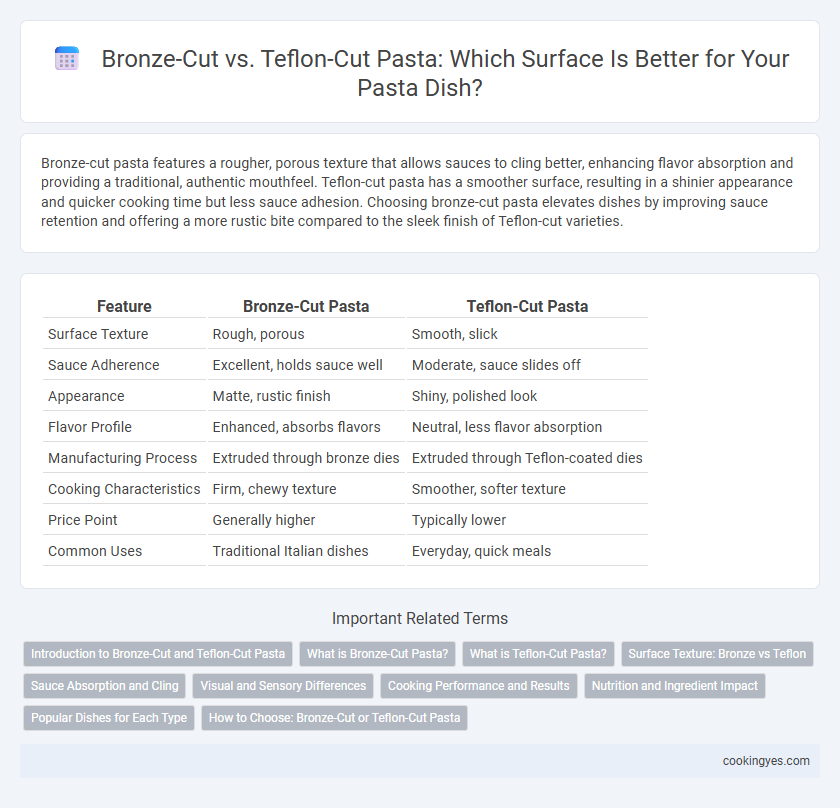Bronze-cut pasta features a rougher, porous texture that allows sauces to cling better, enhancing flavor absorption and providing a traditional, authentic mouthfeel. Teflon-cut pasta has a smoother surface, resulting in a shinier appearance and quicker cooking time but less sauce adhesion. Choosing bronze-cut pasta elevates dishes by improving sauce retention and offering a more rustic bite compared to the sleek finish of Teflon-cut varieties.
Table of Comparison
| Feature | Bronze-Cut Pasta | Teflon-Cut Pasta |
|---|---|---|
| Surface Texture | Rough, porous | Smooth, slick |
| Sauce Adherence | Excellent, holds sauce well | Moderate, sauce slides off |
| Appearance | Matte, rustic finish | Shiny, polished look |
| Flavor Profile | Enhanced, absorbs flavors | Neutral, less flavor absorption |
| Manufacturing Process | Extruded through bronze dies | Extruded through Teflon-coated dies |
| Cooking Characteristics | Firm, chewy texture | Smoother, softer texture |
| Price Point | Generally higher | Typically lower |
| Common Uses | Traditional Italian dishes | Everyday, quick meals |
Introduction to Bronze-Cut and Teflon-Cut Pasta
Bronze-cut pasta features a rough, porous surface created by extruding dough through bronze dies, enhancing sauce adhesion and delivering a traditional texture. Teflon-cut pasta is produced using non-stick Teflon dies, resulting in a smooth surface that offers a silky texture but less sauce retention. The choice between bronze-cut and Teflon-cut affects pasta's mouthfeel and how well it holds sauces, influencing the overall dining experience.
What is Bronze-Cut Pasta?
Bronze-cut pasta is made using bronze dies that create a rough and porous surface, allowing sauces to cling better and enhancing flavor absorption. This traditional method contrasts with teflon-cut pasta, which produces a smoother surface that may not hold sauce as effectively. The texture of bronze-cut pasta also adds a rustic, artisanal quality highly favored in premium pasta varieties.
What is Teflon-Cut Pasta?
Teflon-cut pasta features a smooth surface created by extruding dough through Teflon-coated dies, resulting in a less porous texture compared to bronze-cut pasta. This smooth finish reduces sauce adherence, making it ideal for lighter or oil-based sauces rather than thick, chunky ones. The non-stick properties of Teflon dies allow for faster production but compromise the traditional rough texture prized for better sauce absorption.
Surface Texture: Bronze vs Teflon
Bronze-cut pasta features a rough, porous surface that enhances sauce adhesion, resulting in more flavorful dishes, while Teflon-cut pasta has a smoother, shinier finish that allows sauces to slide off more easily. The abrasive nature of bronze dies creates microscopic grooves on the pasta's surface, improving texture and mouthfeel. In contrast, the non-stick properties of Teflon dies produce a less textured pasta that is often preferred for lighter sauces.
Sauce Absorption and Cling
Bronze-cut pasta features a rougher, more porous surface that enhances sauce absorption and cling, allowing flavors to adhere better and deliver a richer taste experience. Teflon-cut pasta, by contrast, has a smoother texture that repels sauce, resulting in less cling and a milder flavor integration. Chefs often prefer bronze-cut pasta for robust sauces like ragu, as the textured surface captures and holds the sauce more effectively.
Visual and Sensory Differences
Bronze-cut pasta features a rougher, porous surface that enhances sauce adhesion and provides a rustic, artisanal appearance with a matte finish. In contrast, Teflon-cut pasta has a smoother, shinier surface resulting in a sleek texture that offers less sauce retention but a firmer bite. Sensory differences are notable as bronze-cut pasta delivers a chewier mouthfeel and richer flavor absorption, while Teflon-cut pasta tends to cook more uniformly with a slightly lighter texture.
Cooking Performance and Results
Bronze-cut pasta features a rough texture that enhances sauce adherence and improves flavor absorption, resulting in a more authentic Italian dining experience. Teflon-cut pasta provides a smoother surface, allowing for quicker cooking times but often leading to less sauce retention and a more slippery mouthfeel. Choosing bronze-cut pasta generally yields superior cooking performance and better sauce integration, essential for dishes reliant on rich, robust flavors.
Nutrition and Ingredient Impact
Bronze-cut pasta features a rougher surface that enhances sauce adhesion and allows better absorption of flavors without altering the nutritional content. In contrast, Teflon-cut pasta has a smoother surface, which may result in less sauce retention but does not significantly affect ingredient composition or nutrient availability. Both cutting methods maintain the same base ingredients, so differences in texture and sauce interaction are the primary factors influencing the overall sensory experience rather than nutritional impact.
Popular Dishes for Each Type
Bronze-cut pasta offers a rough texture that clings exceptionally well to thick, hearty sauces, making it ideal for traditional dishes like ragu alla Bolognese and rich meat-based ragus. Teflon-cut pasta, characterized by its smooth surface, works best with lighter, delicate sauces such as simple olive oil and garlic or fresh tomato and basil, which highlight the pasta's silky texture. Chefs often choose bronze-cut pasta for complex, slow-cooked dishes, while Teflon-cut pasta is favored in recipes emphasizing subtle flavors and quick preparation.
How to Choose: Bronze-Cut or Teflon-Cut Pasta
Choosing between bronze-cut and teflon-cut pasta hinges on texture preference and sauce adherence. Bronze-cut pasta features a rougher surface, promoting better sauce absorption and a traditional, artisanal mouthfeel, ideal for hearty and chunky sauces. Teflon-cut pasta offers a smoother surface, resulting in a silkier texture and is typically favored for delicate, lighter sauces or when a refined appearance is desired.
Bronze-cut vs Teflon-cut for pasta surface Infographic

 cookingyes.com
cookingyes.com